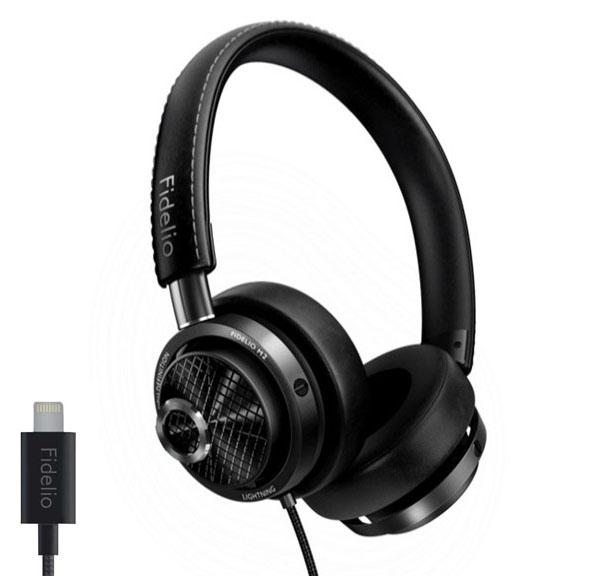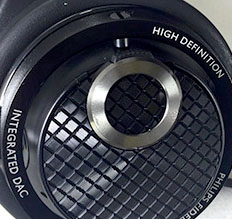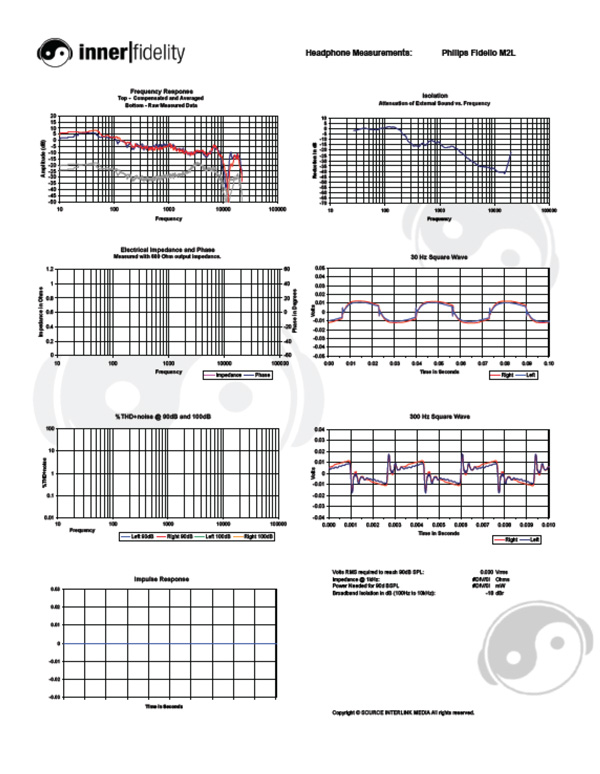| Columns Retired Columns & Blogs |
Philips Fidelio M2L First Lightning Connector Headphone

This story originally appeared at InnerFidelity.com
The First Lightning Cable Headphone
You'd think Apple would be first...or Beats. Nope. The folks at Philips Fidelio have yet again shown they're on the ball and have produced the world's first Lightning connector cabled headphones.
You can read more about the standard Lightning connector for headphone spec here, but basically it provides power for the headphones; a stereo digital audio signal to the headphone up to 24bit/48kHz; and a mono return channel for microphone audio up to 24bit/48kHz. There is also a second more comprehensive standard for headphones that adds additional capabilities, for example, noise canceling and biometric sensing in headphones.
The Philips Fidelio M2L gets both power and digital signals through the Lightning connector to feed a digital to analog converter and headphone amplifier within the headphones. I verified with Philips engineers that the M2L does not have any DSP or advanced tuning functions. Tuning is done through the acoustic design of the headphones.
Down to brass tacks, the Philips Fidelio M2L ($299) is a sealed, on-ear headphone. Construction materials are very nice with a mix of high-quality synthetics and metal. The headband is real leather covered, and while the padding is minimal the lightweight of the headphones doesn't require much. I found the comfort quite good.
Earpads apear to be a high-grade artificial leather and do not apear to be replaceable. These earpads remind me of the Philips Citiscape Downtown that used the term "MusicSeal" for the isolation features of their ear pad, which worked very well. The M2L likewise seems to both isolate and prevent leakage of your music to others very well.
Ear pieces rotate forward 90 degrees to lay flat on a table, and rotate rearward about 45 degrees. Tightness when worn around the neck is a little too much for my fat neck, but most folks should have no problems. Accessories are a bit slim with only a velour bag additionally included. 'Course, no need for a 3.5mm to 1/4" or airplane adaptor with these cans.
The permanently mounted cable is attached to the right ear. Cable is a stiff-ish ribbed material that reminds me of some of the Sony headphones, and which I found to get very stiff in the cold weather. It's warm here in Montana now, but I put these cans in the freezer for a few minutes and found the cable didn't seem nearly as stiff as the Sony when cold, but it's still a little stiffer cable on the whole than I would like.
 A momentary rocker switch on the right earpiece allows for up/down volume adjustment. The central part of the outside of the right earpiece is a button with: one push for pause; two pushes for track forward; and three pushes for track back. Controls are ergonomically positioned and intuitive to use.
A momentary rocker switch on the right earpiece allows for up/down volume adjustment. The central part of the outside of the right earpiece is a button with: one push for pause; two pushes for track forward; and three pushes for track back. Controls are ergonomically positioned and intuitive to use.
Oddly missing from these cans is a microphone for headset use. It seems to me that Philips desire to be first to market with these cans may have caused them to not produce a fully featured product. Whether that was a good idea or not is somewhat out of my bailiwick. I can definitely see that being first with a Lightning connectored headphone may have had significant marketing and cred-garnering value. But as a product reviewer looking at the complete product I just have to find it somewhat wanting for features at this price; the microphone may have been enough to put it over the line.
These are $300 headphones with a very simple feature set and functionality. Yes, they're ahead of the curve with the Lightning connector, but they don't have a microphone and can't be used as a phone headset. So you're actually loosing functionality against a more traditional headphone with a remote on the cable. And if your iPad runs low on juice you can't charge it and have your headphones plugged in at the same time.
Sound Quality
Sound quality is really excellent...were it not for about 5dB too much bass below 150Hz. I'm all for a bass boost down there of up to 4dB, but the M2L reaches 10dB of boost around 40Hz resulting in far to much bass for me when listening to music. Fortunately it doesn't bleed up into the mid-range, which would create an overly thick sound. Bass lovers might dig the M2L however, because, as I said, the sound quality is quite good otherwise. The thing is, when I listen to music the significant difference between bass and mid-range levels sound very disjointed to me.
The odd thing is, I think I like this sound profile quite a bit for movie listening. I've been using these cans quite heavily for Netflix watching on my iPad at night and have really been enjoying them. I'm beginning to wonder if there's some reason to believe movie watching benefits from a little more bass. They don't sound nearly as disjointed to me when watching films...in fact a bit of enhanced heft down low often improves the experience, it seems to me.
Summary
While the mid-range and treble response were excellent, the bass was significantly too strong for me when listening to music, resulting in a very disjointed listening experience for me. If you're a bass-head and an Apple fan wanting to be ahead of the curve by possessing the first headphone with a Lightning connector, the Philips Fidelio M2L will likely be a satisfying headphone for you. Just be forewarned there is no microphone, so they can't be used as a headset.
For the rest of us, I tend to think the bleeding edge is not really a place to get a lot of value for money, and the M2L does seem to fall short considering the $300 price tag. On the other hand, aside from having too much bass, the sound quality is very encouraging and I suspect a six month wait until after the 2016 Consumer Electronics Show in January will find us with more Lightning connector options, and hopefully improved offerings from Philips.
Video
Click on graphs image to download .pdf for closer inspection.
The Philips M2L uses a lightning connector to receive power and digital input signals from compatible Apple devices. It is therefor impossible for me to test these headphones using my normal test routines. I was, however, able to load my iPad with white noise, 30Hz and 300Hz square waves, in order to acquire frequency response and square wave plots. I was also able to measure isolation.
Looking at the raw frequency response we can see that the response between about 100Hz to 10kHz is nearly ideal relative to the target response curve.

Current best approximation of the Harman target response is the black line in the above plot.
Below 100Hz however the bass continues to rise ending up some 10dB above baseline in a broad peak. In listening tests I heard the response above 200Hz as very good, but with so much abrupt bass boost below that the sound was significantly discontinuous.
30Hz square wave shoulder rising significantly above the initial transient spike indicates a strong bass emphasis relative to the treble. Upward hump continues to show low bass emphasis, but also might be an indicator that it has low distortion in the bass. Unfortunately, I couldn't make the THD+noise measurements.
300Hz square wave show a nicely speedy initial transient, unfortunately followed by second and third lower level blips; other than these three features the signal is quite clean, however. I must say I thought the overall treble performance was quite good with these cans. The problem was that listening carefully for treble performance was a bit difficult with the bass so prominent—it made the treble seem laid back, when it really wasn't. In movie watching, speech intelligibility was excellent.
At -18dBr broadband, the isolation of these cans is very good for an on-ear headphone. These cans will do fine as a commuter can in moderately noisy environments, but not quite enough
- Log in or register to post comments





































